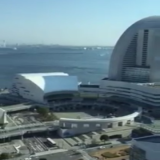This is the fourth and final post from a Toyota press trip. As we entered Toyota’s headquarters in Toyota City, I realized I hadn’t written or edited a major story about Toyota since 1985 when we put “Toyota’s Fast Lane” on the cover of Business Week. Most of my automotive writing since that era was concentrating on how General Motors responded to Toyota in ‘Why GM Matters” (2009) and most recently in the long piece I did about Hyundai Motors for Strategy + Business in 2012. My overall impression of Toyota was that they were big (in fact, No. 1 in the world) but they had gotten there on the basis of their lean manufacturing system. As an incumbent, they seemed flat-footed, as seen in their response to the U.S. recall crisis. And their products have never excited me. They make cars that don’t break and get great mileage, but they might as well be refrigerators on wheels. There isn’t as much emotional connection as I find with American or European premium cars.
So we sat through two presentations one afternoon. I thought they were going to be as boring as watching rice grow. But as I listened, I realize that Toyota, under CEO Akio Toyoda, is preparing a dramatic resurgence that will hit by 2015. It is on both the cost and design fronts.
Mitsuhisa Kato, an executive vice president in charge of R&D and planning, and also a member of the company’s board of directors, started off by talking about Toyota’s New Global Architecture (TNGA.) Yeah, yeah, I thought. How many times have I heard this kind of blather? But Kato (pictured, below) explained that Toyota is striving to find ways to share more parts among its different vehicles. It knows it needs to customize some vehicles for specific markets, but for vehicles that it sells in multiple markets, it is trying to find ays to share the nuts and bolts and other components that go into their vehicles.
I woke up when Kato said they are targeting 15 percent to 20 percent reductions in manufacturing costs by doing this. They intend to reinvest those gains in their products. They also will achieve major weight losses in their vehicles and will be able to reduce lead times, meaning new models get to market faster.
I asked Kato who was driving this process. Was it being driven from the ground up or from the top down, meaning from Akio Toyota? “It’s the instruction coming from top management,” he replied. In other words, Akio Toyoda is trying to rev his company up.
If Toyota can achieve these goals, everyone else in the industry is going to feel it. The target date for it to hit is 2015. A lot of things are going to happen in 2015. That’s going to be a key year for Toyota and hence the entire industry.
Then another executive got up, Tokuo Fukuichi, a senior managing officer in charge of Design. He made it clear that Toyota is going to shake out of its old design ways and go for the “keen look” or what he also called the “edgy design.” Toyota obviously recognizes that its cars have been on the dull side in terms of physical appearance–Hyundai’s gains against them have come in part because the Koreans took greater design risks. Now Toyota is going to change the game. This new Lexus IS 250 Sport F tells part of the story:
We didn’t see or drive this vehicle but the early photographs suggest that Fukuichi is deadly serious. Toyota is starting to introduce designs that excite.
So if the company can both drive down its costs by 15 to 20 percent, while introducing exciting designs, the auto world will feel The Empire striking back.






